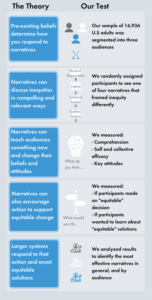In 2015, the USA Network show Royal Pains featured a brief storyline about a transitioning transgender teen and the challenges she faced. The episode aired during a period of unprecedented media attention on the transgender community. The transgender rights movement was gaining momentum, but also experiencing backlash.
Unlike other popular shows at the time (e.g., Transparent), Royal Pains did not routinely address LGBTQIA issues. In the midst of this charged environment, the episode gave the Royal Pains audience – who represented a broad ideological spectrum – an opportunity to engage with transgender rights as a story, rather than a policy.
This narrative approach was impactful. Researchers from University of South California’s (USC’s) Annenberg School for Communication and Journalism teamed up with the school’s Norman Lear Center (NLC) – a nonpartisan center of research and innovation that studies and shapes the impact of media and entertainment on society – to assess the episode’s impact. They compared Royal Pains viewers who saw the episode with regular Royal Pains viewers who had not yet seen it.
The researchers found that viewing this episode was associated with more supportive attitudes towards transgender people and relevant policies. Further, this eleven-minute fictional narrative was more influential than news stories, including those about the Caitlyn Jenner transition, which was widely covered at the time.
Royal Pains isn’t an isolated example. Stories provide an accessible way of presenting complex issues. They make it easier for us to relate to people from different backgrounds. Stories’ ability to transport us can also make us less likely to push back against the assumptions in a narrative. They can even change health behaviors; researchers have found that story-based interventions can increase rates of cervical cancer screening and encourage safer sex.
Given their power, we wanted to explore how narratives could be used to tell a new story about inequities, particularly in the context of health. Dominant narratives in the U.S. focus on personal responsibility, suggesting individuals are primarily responsible for their health outcomes through their choices and behavior. But evidence shows that health outcomes reflect the broader conditions individuals live, work, and play in.
Therefore, addressing health disparities requires a shift in: thinking, individual action, and structural change. Only then can we ensure that “everyone has a fair and just opportunity” to be healthy, happy, and productive. Increasingly, narratives in media and entertainment address social determinants of health, but storytellers and policymakers need more evidence to understand what types of narratives work, and for whom.
In 2019, with support from the Robert Wood Johnson Foundation, BIT partnered with Norman Lear Center’s Media Impact Project (MIP) to test the impact of four types of narratives on audience mindsets and behaviors. We found that (1) “hybrid” narratives are useful for a wide audience; (2) narratives are more effective when they specifically make connections between conditions, policies, and outcomes; and (3) we identified avenues for further research on online platforms. Read on for more details on what we did and our findings and visit MIP’s Narratives of Health Equity website for more detail on their research.
We designed an online experiment to test the impact of four narratives on mindsets and behaviors
In an online Predictiv experiment, we tested the impact of four text-based narratives on a large sample of 16,936 adults in the U.S. Survey participants were segmented into three “audiences” composed of people with similar ideologies and media habits. The four narratives were based on existing entertainment narratives that MIP identified through qualitative research.
Participants were randomized to read one of four narratives about Nathan, a fast-food worker who goes to a barbecue and is exposed to COVID-19. The narratives vary in how they frame the causes of and solutions for his subsequent health and financial issues; more detail on these narrative frames can be found below.
See Figure 1 for an excerpt from the “systemic solution” narrative:
I’m wondering if I might have caught COVID at the barbecue. [But] then I started thinking about other places I could have been exposed…I don’t have a car so I have to take the bus to work…plus I am around people all day at my fast food job…it was my choice to go to the barbecue, but all of the other places I might have been exposed were out of my control. No matter where I got it, I’m still the one who has to pay the price. My coworkers found out about my decision to stay home from work to protect them. They thought about banding together to start a GoFundMe…but they decided instead that it should really be the government’s responsibility to take care of the community and keep everyone healthy.
Figure 1. Excerpt from the systemic solution narrative
Participants were asked a series of questions to measure comprehension, attitudes, and behaviors of interest: making an equitable decision or learning more about equitable policy.
See Figure 2 below for more details on our experimental design:

Figure 2. Our theory of change and experimental design
We found a narrative approach that works for a wide audience and identified avenues for future research
Storytellers should take a “hybrid” approach to discussing contentious issues. Hybrid narratives – which contextualize individual behavior, demonstrating how inequitable conditions shape peoples’ choices and actions – are a “safe bet” for an audience of mixed ideology.
We tested four narrative frames in this experiment. The “personal responsibility” narrative emphasized how Nathan’s individual choices put him at risk. The “hybrid” narrative added context to demonstrate how inequitable conditions contributed to his exposure.
The final two narratives built on the “hybrid” narrative by offering solutions to Nathan’s problem. In the “individual solution” narrative, Nathan’s coworkers raised funds to help Nathan but ultimately did not address the underlying inequity. The “systemic solution” narrative illustrated how collective action for equitable policies could not only help Nathan, but also address the root cause of the problem.
We found that participants shifted blame (for Nathan’s exposure) according to who or what the narrative emphasized was at fault. Participants who read any of the three hybrid narratives were more likely to say that his employer’s policies, large businesses, or government policy share the blame. Regardless, personal responsibility remained important to all audiences.
We did not see any evidence of a backfire effect when participants viewed a narrative that contradicted their pre-existing beliefs, even among the more conservative audience who viewed the systemic solution narrative.
These findings suggest that hybrid narratives can be effective with diverse audiences – and so could be used in entertainment that reaches people with a range of beliefs – and may be able to shift thinking around who should be responsible for addressing inequities.
The most influential narratives are those that help audiences make the connection between conditions, policies, and outcomes. Specific narratives that explicitly mention the policies of interest can be particularly persuasive.
One behavioral measure asked participants to decide how to allocate a hypothetical medication to prevent COVID-19. Options included: first come first serve, a lottery, or equity-driven allocation to high-risk groups first.
Regardless of the narrative they read, most participants said they would allocate the medication to high-risk groups, but they differed in who they considered high-risk. Those who read any of the three hybrid narratives were more likely to say that not having health insurance – which was directly mentioned in the story – should classify someone as high-risk and therefore make them more likely to receive the medicine.
Hybrid narratives also increased support for policies, like paid sick leave, that would address Nathan’s specific circumstances. Narratives that offered a systemic solution increased support for related topics that weren’t explicitly mentioned like the suspension of rent payments and guaranteed unemployment benefits. However, those narrow attitude shifts didn’t transfer as strongly to more abstract attitude changes on broader topics of justice and government responsibility.
While these findings suggest that specificity is important, to understand how to make narratives as impactful as possible, further research could explore what types of attitudes (e.g., about specific policies or about abstract beliefs) best predict behavior.
Online experiments are cost-effective ways of getting early findings, with populations of interest, before moving to complex field trials.
Online experiments allow us to test theories and approaches without real-world risks, which, given the power and reach of popular media narratives, could be significant. We suggest using this approach to confirm and expand on these findings to test video formats, narratives with different main characters, or narratives that more explicitly discuss or model the behaviors of interest.
For more information on this project, please contact BIT.
Support for this research was provided by the Robert Wood Johnson Foundation. The views expressed here do not necessarily reflect the views of the Foundation.




